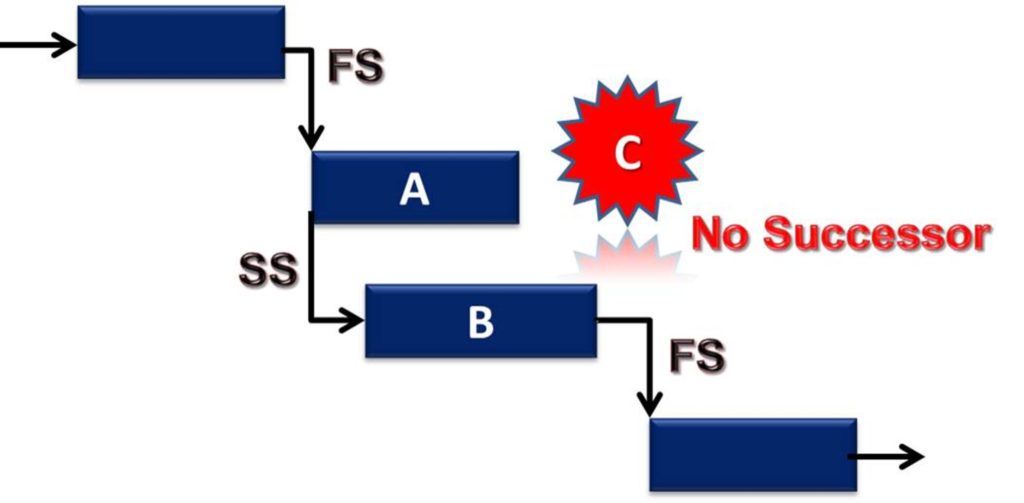
A recent query from a colleague inspired me to write this short article on the subject of danglers, i.e. schedule danglers. I hope my humble insights will be useful.
OPEN START DANGLER
Open start danglers are activities where the only predecessor is either Finish-to-Finish or Start-to-Finish, resulting in an open start to the activity. They are also known as “dangling activities.”
The number of activities with open start (danglers) should be zero.
The project scheduler should use Start-to-Start and Start-to-Finish links sparingly. Tie each activity end completely and properly to avoid danglers.
In Figure 1, Activity A is connected Finish-to-Finish (FF) to Activity B. However, Activity B remains a dangler. It needs to have a predecessor, say an Activity C connected to its start date in order to complete the proper logic link.
The solution is to tie both ends of any activity. This is an important requirement to accurately calculate the schedule and iterate all risk inputs, providing a reliable output. This deficiency is usually not detectable by scheduling tools. It is not found in the typical log report (e.g. P6) nor anywhere else. The project needs an analytic tool designed to capture it (e.g. Acumen Fuse).
Figure 1

OPEN FINISH DANGLER
Open finish danglers are activities where the only successor is either a Start-to-Finish or Start-to-Start, resulting in an open finish dangler situation. They are called “dangling activities.”
The number of open finish danglers should not be greater than zero.
Whenever possible, this means that the number of activities with this type of dangler should be zero. As with the Open Start Dangler, the project scheduler should use the Start-to-Start and Finish-to-Finish ties sparingly.
Both ends of the activity should be tied to another activity to avoid danglers. In Figure 2, Activity A is connected using Start-to-Start logic to Activity B. In this case, Activity A is the dangler. It needs to have a successor Activity C connected to it in order to complete the proper logic. If not, it will be reported as a dangler.
Figure 2

The solution is to tie both ends of any activity. This is an important requirement to accurately calculate and iterate all risk inputs and provide a reliable output. This deficiency is not detectable by the Primavera Scheduling tool, and is not part of the P6 Log Report. The project needs an analytic tool designed to capture it.
Dangler activity behave very similarly with the typical open ended activity. Nothing is effectively controlling the behavior of the activity. No dependency is established. Open ends, such as missing successors or predecessors, or danglers, cause schedule and risk analysis calculations to be erroneous.

And, here’s a reminder to Project Gate Reviewers and Auditors.
Open ends are great indicators of missing scope/s, incomplete and/or missing planning inputs. The solution is to tie all valid network activities in the right sequence, according to the approved project execution plan and path of construction.
A good schedule is a well-tied schedule and a well-tied schedule signifies complete scope.
Source: Frago, R. (2015/2017).Plan to Schedule, Schedule to Plan.ISBN 978-0-9947608-2-1.Canada
About the Author:
Rufran C. Frago is the Founder of PM Solution Pro, a Calgary consulting, product, and training services firm focusing on project and business management solutions. He is passionate providing advice, mentorship, education and training through consultation, collaboration, and what he uniquely calls, student-led training.
BOOKS AUTHORED BY RUFRAN FRAGO
- Risk-based Management in the World of Threats and Opportunities: A Project Controls Perspective.ISBN 978-0-9947608-0-7.Canada
- Plan to Schedule, Schedule to Plan.ISBN 978-0-9947608-2-1.Canada
- How to Create a Good Quality P50 Risk-based Baseline Schedule.ISBN 978-0-9947608-1-4.Canada
- Schedule Quantitative Risk Analysis (Traditional Method).ISBN 978-0-9947608-3-8.Canada
